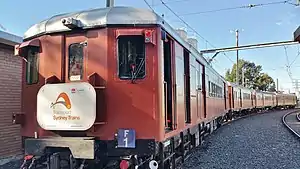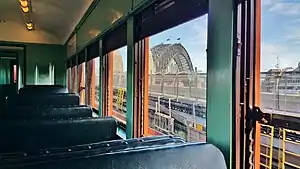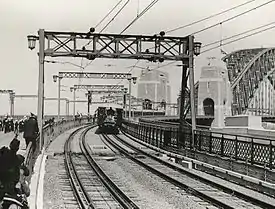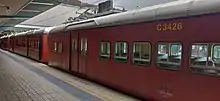New South Wales Standard suburban carriage stock
The New South Wales Standard suburban carriage stock are a class of electric multiple units that were operated by the New South Wales Government Railways and its successors between 1926 and 1992. They served on the Sydney suburban network. In the years before their withdrawal, they were nicknamed Red Rattlers.This term was imported from Victoria and was never a comtemporaneous colloquialism.
| New South Wales Standard suburban carriage stock | |
|---|---|
 | |
 Interior | |
| In service | 1925-1992 |
| Manufacturer | |
| Built at | |
| Constructed | 1925-1937 |
| Number built |
|
| Formation | 2-8 carriages |
| Fleet numbers |
|
| Operator(s) | |
| Depot(s) | |
| Line(s) served | All Sydney suburban except Eastern Suburbs |
| Specifications | |
| Car length | 18.75 m (61 ft 6+1⁄4 in) |
| Width | 3,185 mm (10 ft 5+3⁄8 in) |
| Height | 3,920 mm (12 ft 10+3⁄8 in) |
| Doors | 4 |
| Maximum speed | 80 km/h (50 mph) (TfNSW limit) 3000 series cars: 80 km/h (50 mph) (designed speed) 7000 series cars: 113 km/h (70 mph) (designed speed) 20 km/h (12 mph) through platforms |
| Traction system | 3000 series cars: 2 x Metropolitan-Vickers 172s per carriage 7000 series cars: 4 x AEI 149 per carriage Semi automatic stepped resistance control (Electro-pneumatic), Series wound DC traction motors |
| Transmission | 3000 series cars: 58:18 Gear ratio with Train wheel axle hung on traction motors geared with Spur gears. Wheel diameter 42 inch (1067mm) 7000 series cars: 74:17 Gear ratio with Train wheel axle hung on traction motors geared with helical gears. Wheel diameter 36 inch (914mm) |
| Electric system(s) | 1,500 V DC catenary |
| Current collector(s) | Single-pan diamond pantograph |
| Braking system(s) | Westinghouse air |
| Track gauge | 1,435 mm (4 ft 8+1⁄2 in) standard gauge |
History

To provide rolling stock for the electrification of Sydney's suburban rail network, steel carriages were ordered.[1][2]
The initial 50 power cars were built in England by Leeds Forge Company and shipped to Australia in knocked-down condition. They were assembled by Eveleigh Carriage Workshops (10) and Clyde Engineering (40) between April and October 1925. Initially numbered 2213-2262, they entered service being inserted into sets with Bradfield carriages for haulage by steam locomotives until fitted with Metropolitan-Vickers electrical equipment and motors in 1926. At this stage they were renumbered C3101 to C3150.[1][2][3]
Between 1926 and 1929, a further 290 power cars, 248 trailer cars and three parcel vans were built in Australia by Clyde Engineering and Walsh Island Dockyard.[4] In 1937, Clyde Engineering built a further 12 power cars, to provide coverage while the 1920s built power cars were overhauled.[5] The reason for the imbalance between motor and trailer cars was the conversion of some American Suburban carriage stock to operate with the new power cars.[1][2]
| Numbers | Builder | Years Built | Total | Notes |
|---|---|---|---|---|
| C3101-C3150 | Leeds Forge Company | 1925 | 50 | Initially entered service as locomotive hauled carriages 2213-2262 |
| C3151-C3170 | Clyde Engineering | 1926-27 | 20 | |
| C3171-C3220 | Walsh Island Dockyard | 1926-27 | 50 | |
| C3221-C3250 | Clyde Engineering | 1926 | 30 | |
| C3251-C3300 | Walsh Island Dockyard | 1928 | 50 | |
| C3301-C3440 | Clyde Engineering | 1928-29 | 140 | |
| C3441-C3452 | Clyde Engineering | 1937 | 12 | |
| C3901-C3903 | Clyde Engineering | 1928 | 3 | Parcel vans |
| T4301-T4548 | Walsh Island Dockyard | 1927-29 | 248 | T4543-T4548 rebuilt as driving trailers D4051-D4056 in 1937 |
In 1937, six trailers (T4543-T4548) were converted to driving trailers.[2] Between 1968 and 1975, some power cars were converted to 4 motors using traction equipments similar the W sets and U sets and fitted on air suspended bogies. These were renumbered upwards by 4000, e.g. C3306 became C7306.[6]
Withdrawals commenced in the 1970s, 92 remained in service with CityRail in July 1991.[6] The last were withdrawn in 1992. Several have been preserved.[3][7][8][9][10][11]
Colour schemes and overhauls

As built, the standard cars were painted in Tuscan red and russet with yellow pin striping.[12] In the 1940s, that was changed to Tuscan red with buff lining.[12] In 1957, the livery was changed to plain Tuscan red, which many cars retained until their withdrawal.[12] From 1973, the livery became Public Transport Commission blue and white, before that was superseded by Indian red in 1976. The original cream and brown interiors were repainted in two-tone green, but that was not done to all cars. Overhauls of the stock continued up until 1988, with some receiving sliding aluminium Beclawat windows to alleviate rust problems.[3][5][6] A few cars also received Airmate pantographs, replacing the original Dorman Long pantographs.[12]
Preservation
Set F1, which is made up of four carriages (C7396, C3218, T4527, C3426), is preserved and in operational condition. This is as a result of collaboration between Sydney Trains, Transport Heritage NSW, who plan public trips and tours on the train, and Historic Electric Traction. The restored train resumed carrying passengers on June 11, 2016, 14 years since its last such trip.[13][14] One of the carriages of set F1, power car C3426, led the first electric train to cross the Sydney Harbour Bridge. All four cars were built in 1927.[15]
Transport Heritage NSW / Sydney Trains has multiple Standard cars in the care of Historic Electric Traction:[16]
- C3102 - Leeds Forge (2 motor) Power Car - Stored at Redfern Carriageworks
- C3218 - Walsh Island (2 motor) Power Car - Operational at Flemington Car Sheds
- C3426 - Clyde Engineering (2 motor) Power Car - Operational at Flemington Car Sheds
- C3653 - Walsh Island (2 motor) Parcel Van (ex C3903, C3553, C3773) - Stored at Redfern Carriageworks
- C7396 - Clyde Engineering (4 motor) Power Car (ex C3396) - Operational at Flemington Car Sheds
- D4052 - Walsh Island Driving Trailer Car (ex T4547, D4673) - Stored at Redfern Carriageworks
- T4527 - Walsh Island Trailer Car - Operational at Flemington Car Sheds
Walsh Island Trailer Car T4310, owned by Transport Heritage NSW / Sydney Trains, is on static display at NSW Rail Museum, Thirlmere. The Dorrigo Steam Railway and Museum own one standard power car, Clyde Engineering (2 motor) power car C3167, stored at Dorrigo.[17]

Due to their width and old traction equipment, Transport for NSW limits the speed of these carriages to 80 km/h during normal running and 20 km/h when passing platforms. They are further limited to running in wide loading gauge track areas only, which includes the whole suburban network, but does not include the Main North or West lines leaving Sydney.
See also
References
- Churchman, Geoffrey (1995). Railway Electrification in Australia & New Zealand. Smithfield: IPL Books. pp. 85, 92.
- "Sydney's Electric Trains from 1926 to 1960" ARHS Bulletin issue 761 March 2001 pages 90-93
- C3104 - 1925 Leeds Forge Standard Motor Car Sydney Electric Traction Society
- History: The old Red Rattlers live on Newcastle Herald 12 September 2014
- C3444 - 1937 Clyde Modified Motor Car Sydney Electric Traction Society
- "Rolling Stock" Railway Digest December 1991 page 454
- C3102 - Leeds 1927 Suburban Motor Car NSW Environment & Heritage
- C3218 - Walsh Island 1927 Suburban Motor Car NSW Environment & Heritage
- C3653 - Walsh Island 1927 Suburban Parcels Van NSW Environment & Heritage
- D4052 - Walsh Island 1927 Suburban Trailer Car NSW Environment & Heritage
- T4527 - Walsh Island 1927 Suburban Trailer Car NSW Environment & Heritage
- Sydney's Suburban Standards - The Leeds Forge Cars C3101 - 3150. Roy Howarth, Glenn Ryan. 2010. pp. Pages 16–21, 70, 76, 77.
- "The Red Set F1 Project – Sydney's Vintage Electric Train". www.schoolpa.com.au. Retrieved 8 January 2018.
- "Sydney Heritage Red Rattler to run after 14 years". Railpage. Retrieved 8 January 2018.
- "NSW Rail Museum". NSW Rail Museum. Retrieved 8 January 2018.
- "Heritage Fleet". www.het.org.au. Retrieved 8 January 2018.
- "Dorrigo Steam Railway & Museum Ltd Web Site". www.dsrm.org.au. Retrieved 4 October 2020.